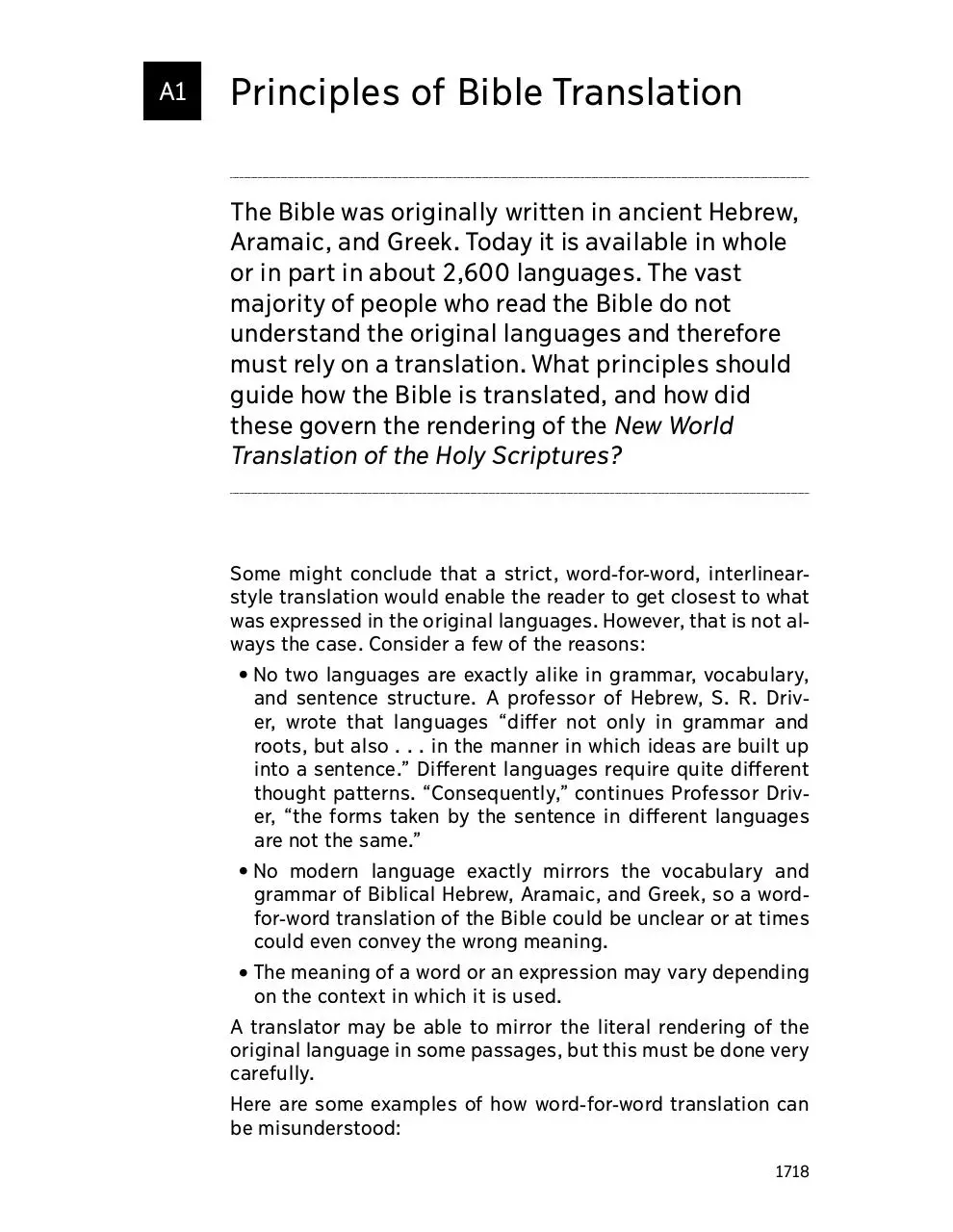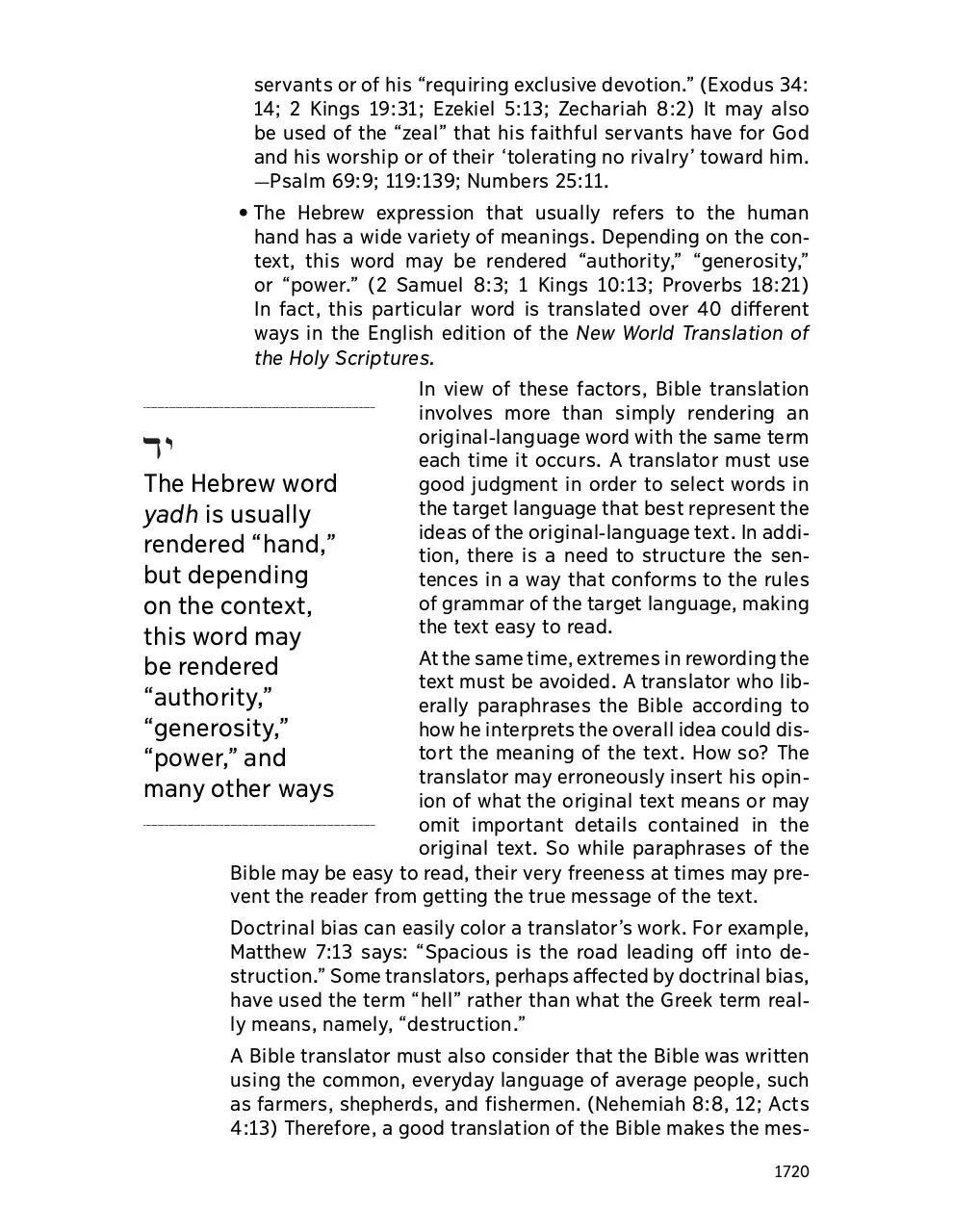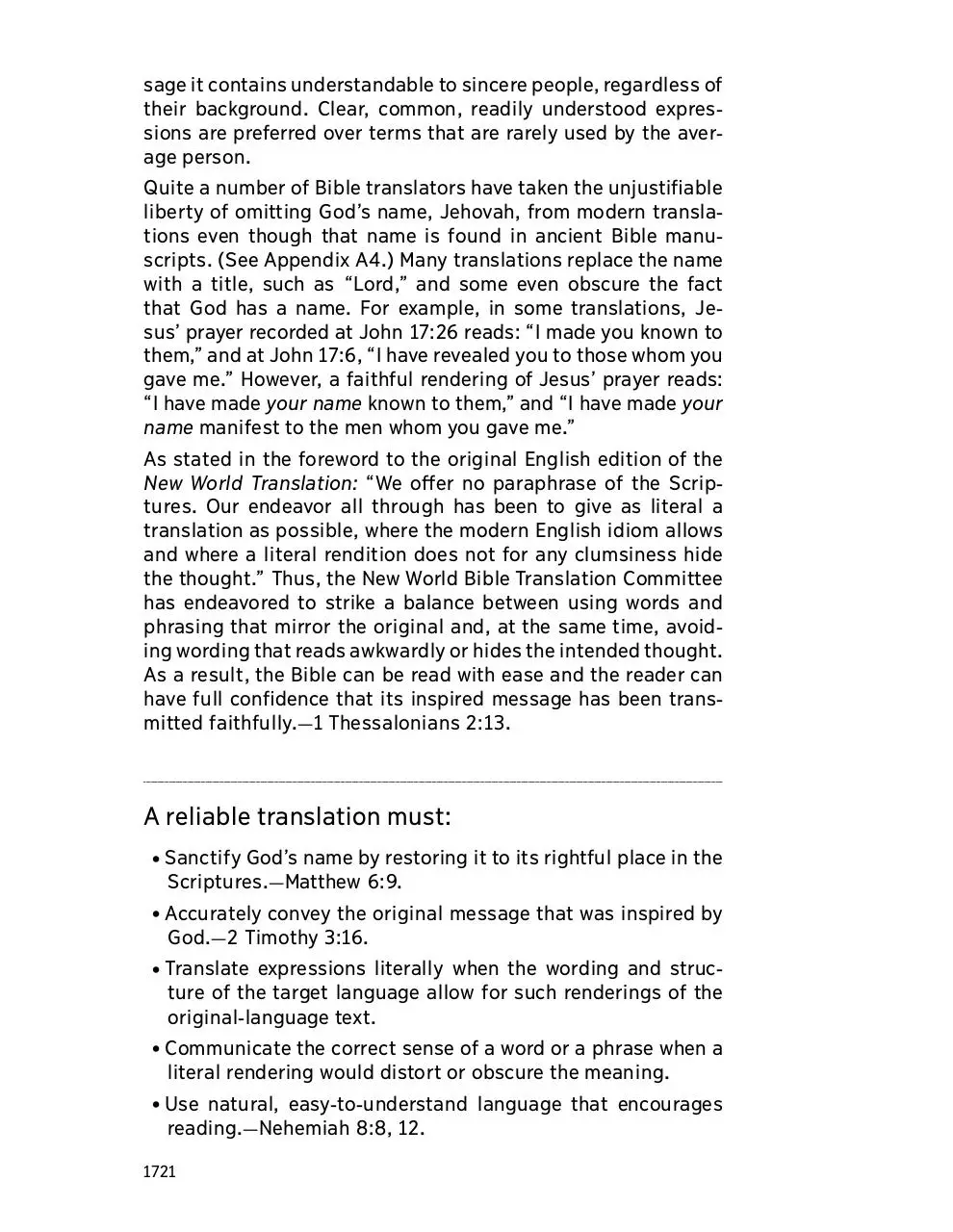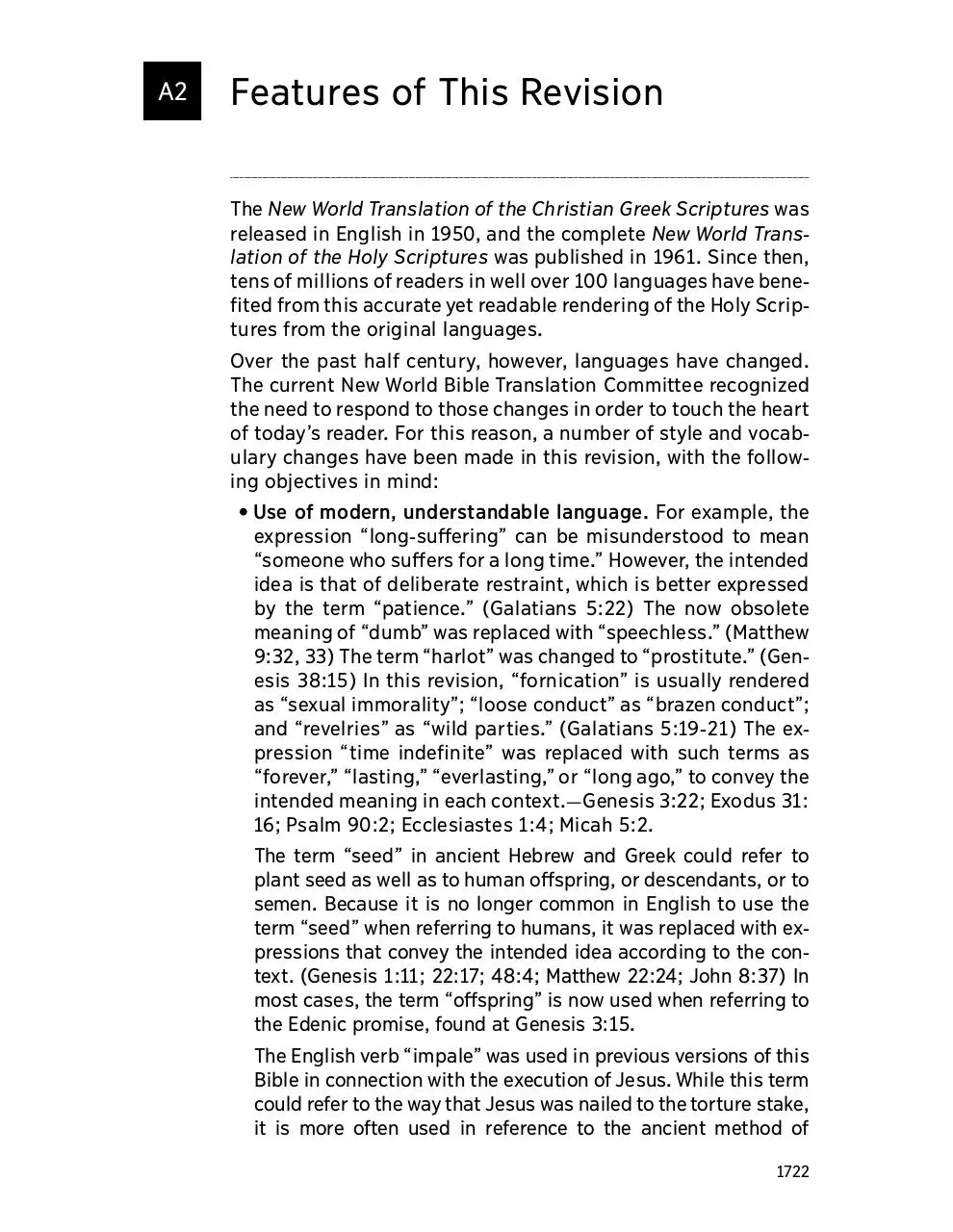Translation Comittee notes (PDF)
File information
Title: nwt_E
Author: JW
This PDF 1.3 document has been generated by Preview / Mac OS X 10.10.5 Quartz PDFContext, and has been sent on pdf-archive.com on 12/08/2016 at 07:49, from IP address 72.222.x.x.
The current document download page has been viewed 1007 times.
File size: 41.44 MB (54 pages).
Privacy: public file





File preview
A1
Principles of Bible Translation
!!!!!!!!!!!!!!!!!!!!!!!!!!!!!!!!!!!!!!!!!!!!!!!!!!!!!!!!!!!!!!!!!!!!!!!!!!!!!!!!!!!!!!!!!!!!!!!!!!!!!!!!!!!!!!!!!!!!!!!!!!!!!!!!!!!!!!!!!!!!!!!!!!!!!!!!!!!!!!!!!!!!!!!!!!!!!!!!!!!!!!!!!!!!!!!!!!!!!!!!!!!!!!!!!!!!!!!!!!!!!!!!!!!!!!!!!!!!!!!!!!!!!!!!!!!!!
The Bible was originally written in ancient Hebrew,
Aramaic, and Greek. Today it is available in whole
or in part in about 2,600 languages. The vast
majority of people who read the Bible do not
understand the original languages and therefore
must rely on a translation. What principles should
guide how the Bible is translated, and how did
these govern the rendering of the New World
Translation of the Holy Scriptures?
!!!!!!!!!!!!!!!!!!!!!!!!!!!!!!!!!!!!!!!!!!!!!!!!!!!!!!!!!!!!!!!!!!!!!!!!!!!!!!!!!!!!!!!!!!!!!!!!!!!!!!!!!!!!!!!!!!!!!!!!!!!!!!!!!!!!!!!!!!!!!!!!!!!!!!!!!!!!!!!!!!!!!!!!!!!!!!!!!!!!!!!!!!!!!!!!!!!!!!!!!!!!!!!!!!!!!!!!!!!!!!!!!!!!!!!!!!!!!!!!!!!!!!!!!!!!!
Some might conclude that a strict, word-for-word, interlinearstyle translation would enable the reader to get closest to what
was expressed in the original languages. However, that is not always the case. Consider a few of the reasons:
˙ No two languages are exactly alike in grammar, vocabulary,
and sentence structure. A professor of Hebrew, S. R. Driver, wrote that languages “differ not only in grammar and
roots, but also . . . in the manner in which ideas are built up
into a sentence.” Different languages require quite different
thought patterns. “Consequently,” continues Professor Driver, “the forms taken by the sentence in different languages
are not the same.”
˙ No modern language exactly mirrors the vocabulary and
grammar of Biblical Hebrew, Aramaic, and Greek, so a wordfor-word translation of the Bible could be unclear or at times
could even convey the wrong meaning.
˙ The meaning of a word or an expression may vary depending
on the context in which it is used.
A translator may be able to mirror the literal rendering of the
original language in some passages, but this must be done very
carefully.
Here are some examples of how word-for-word translation can
be misunderstood:
1718
˙ The Scriptures use the expressions “sleep” and “fall asleep”
to refer both to physical sleep and to the sleep of death. (Matthew 28:13; Acts 7:60) When these expressions are used in
contexts that refer to death, Bible translators can use such
wording as “fall asleep in death,” which helps the modern
reader avoid confusion.—1 Corinthians 7:39; 1 Thessalonians
4:13; 2 Peter 3:4.
˙ The apostle Paul used an expression found at Ephesians 4:14
that can be literally translated “in the playing of dice of men.”
This ancient idiom alludes to the practice of cheating others
when using dice. In most languages, a literal rendering of this
allusion makes little sense. Translating this expression as “the
trickery of men” is a clearer way to convey the meaning.
˙ At Romans 12:11, a Greek expression is used that literally
means “to the spirit boiling.” This wording does not convey
the intended meaning in English, so it is rendered “aglow with
the spirit” in this translation.
˙ During his famous Sermon on the Mount, Jesus used an ex-
pression that is often translated “Blessed are the poor in
spirit.” (Matthew 5:3, King James Version) But in many languages, a literal rendering of this expres!!!!!!!!!!!!!!!!!!!!!!!!!!!!!!!!!!!!!!!!!!!!!!!!!!!!!!!!!!!!!!!!!!!!!!!!!!!!!!!!!!!!!!!!!!!!!!!!!!!!!
sion is obscure. In some cases, a strictly
literal translation could imply that “the
poor in spirit” are mentally unbalanced
or lacking in vitality and determination.
MATTHEW 5:3
However, Jesus was here teaching people that their happiness depended, not
on satisfying their physical needs, but
Literal English:
on recognizing their need for God’s guid“the poor in spirit”
ance. (Luke 6:20) Thus, such renderings
as “those conscious of their spiritual
Idea: “those
need” or “those who know their need for
conscious of their
God” convey more accurately the meanspiritual need”
ing of the original expression.—Matthew 5:3; The New Testament in Modern
!!!!!!!!!!!!!!!!!!!!!!!!!!!!!!!!!!!!!!!!!!!!!!!!!!!!!!!!!!!!!!!!!!!!!!!!!!!!!!!!!!!!!!!!!!!!!!!!!!!!!
English.
˙ In many contexts, the Hebrew word translated “jealousy”
corresponds to the common meaning of the English word,
namely, to feel anger over the apparent unfaithfulness of a
close associate or to envy others for their possessions. (Proverbs 6:34; Isaiah 11:13) However, the same Hebrew word also
has a positive connotation. For example, it may be used of
the “zeal,” or protective ardor, that Jehovah shows for his
1719
servants or of his “requiring exclusive devotion.” (Exodus 34:
14; 2 Kings 19:31; Ezekiel 5:13; Zechariah 8:2) It may also
be used of the “zeal” that his faithful servants have for God
and his worship or of their ‘tolerating no rivalry’ toward him.
—Psalm 69:9; 119:139; Numbers 25:11.
˙ The Hebrew expression that usually refers to the human
hand has a wide variety of meanings. Depending on the context, this word may be rendered “authority,” “generosity,”
or “power.” (2 Samuel 8:3; 1 Kings 10:13; Proverbs 18:21)
In fact, this particular word is translated over 40 different
ways in the English edition of the New World Translation of
the Holy Scriptures.
!!!!!!!!!!!!!!!!!!!!!!!!!!!!!!!!!!!!!!!!!!!!!!!!!!!!!!!!!!!!!!!!!!!!!!!!!!!!!!!!!!!!!!!!!!!!!!!!!!!!!
The Hebrew word
yadh is usually
rendered “hand,”
but depending
on the context,
this word may
be rendered
“authority,”
“generosity,”
“power,” and
many other ways
In view of these factors, Bible translation
involves more than simply rendering an
original-language word with the same term
each time it occurs. A translator must use
good judgment in order to select words in
the target language that best represent the
ideas of the original-language text. In addition, there is a need to structure the sentences in a way that conforms to the rules
of grammar of the target language, making
the text easy to read.
At the same time, extremes in rewording the
text must be avoided. A translator who liberally paraphrases the Bible according to
how he interprets the overall idea could distort the meaning of the text. How so? The
translator may erroneously insert his opinion of what the original text means or may
!!!!!!!!!!!!!!!!!!!!!!!!!!!!!!!!!!!!!!!!!!!!!!!!!!!!!!!!!!!!!!!!!!!!!!!!!!!!!!!!!!!!!!!!!!!!!!!!!!!!!
omit important details contained in the
original text. So while paraphrases of the
Bible may be easy to read, their very freeness at times may prevent the reader from getting the true message of the text.
Doctrinal bias can easily color a translator’s work. For example,
Matthew 7:13 says: “Spacious is the road leading off into destruction.” Some translators, perhaps affected by doctrinal bias,
have used the term “hell” rather than what the Greek term really means, namely, “destruction.”
A Bible translator must also consider that the Bible was written
using the common, everyday language of average people, such
as farmers, shepherds, and fishermen. (Nehemiah 8:8, 12; Acts
4:13) Therefore, a good translation of the Bible makes the mes1720
sage it contains understandable to sincere people, regardless of
their background. Clear, common, readily understood expressions are preferred over terms that are rarely used by the average person.
Quite a number of Bible translators have taken the unjustifiable
liberty of omitting God’s name, Jehovah, from modern translations even though that name is found in ancient Bible manuscripts. (See Appendix A4.) Many translations replace the name
with a title, such as “Lord,” and some even obscure the fact
that God has a name. For example, in some translations, Jesus’ prayer recorded at John 17:26 reads: “I made you known to
them,” and at John 17:6, “I have revealed you to those whom you
gave me.” However, a faithful rendering of Jesus’ prayer reads:
“I have made your name known to them,” and “I have made your
name manifest to the men whom you gave me.”
As stated in the foreword to the original English edition of the
New World Translation: “We offer no paraphrase of the Scriptures. Our endeavor all through has been to give as literal a
translation as possible, where the modern English idiom allows
and where a literal rendition does not for any clumsiness hide
the thought.” Thus, the New World Bible Translation Committee
has endeavored to strike a balance between using words and
phrasing that mirror the original and, at the same time, avoiding wording that reads awkwardly or hides the intended thought.
As a result, the Bible can be read with ease and the reader can
have full confidence that its inspired message has been transmitted faithfully.—1 Thessalonians 2:13.
!!!!!!!!!!!!!!!!!!!!!!!!!!!!!!!!!!!!!!!!!!!!!!!!!!!!!!!!!!!!!!!!!!!!!!!!!!!!!!!!!!!!!!!!!!!!!!!!!!!!!!!!!!!!!!!!!!!!!!!!!!!!!!!!!!!!!!!!!!!!!!!!!!!!!!!!!!!!!!!!!!!!!!!!!!!!!!!!!!!!!!!!!!!!!!!!!!!!!!!!!!!!!!!!!!!!!!!!!!!!!!!!!!!!!!!!!!!!!!!!!!!!!!!!!!!!!
A reliable translation must:
˙ Sanctify
God’s name by restoring it to its rightful place in the
Scriptures.—Matthew 6:9.
˙ Accurately
convey the original message that was inspired by
God.—2 Timothy 3:16.
˙ Translate
expressions literally when the wording and structure of the target language allow for such renderings of the
original-language text.
˙ Communicate
the correct sense of a word or a phrase when a
literal rendering would distort or obscure the meaning.
˙ Use
natural, easy-to-understand language that encourages
reading.—Nehemiah 8:8, 12.
1721
A2
Features of This Revision
!!!!!!!!!!!!!!!!!!!!!!!!!!!!!!!!!!!!!!!!!!!!!!!!!!!!!!!!!!!!!!!!!!!!!!!!!!!!!!!!!!!!!!!!!!!!!!!!!!!!!!!!!!!!!!!!!!!!!!!!!!!!!!!!!!!!!!!!!!!!!!!!!!!!!!!!!!!!!!!!!!!!!!!!!!!!!!!!!!!!!!!!!!!!!!!!!!!!!!!!!!!!!!!!!!!!!!!!!!!!!!!!!!!!!!!!!!!!!!!!!!!!!!!!!!!!!
The New World Translation of the Christian Greek Scriptures was
released in English in 1950, and the complete New World Translation of the Holy Scriptures was published in 1961. Since then,
tens of millions of readers in well over 100 languages have benefited from this accurate yet readable rendering of the Holy Scriptures from the original languages.
Over the past half century, however, languages have changed.
The current New World Bible Translation Committee recognized
the need to respond to those changes in order to touch the heart
of today’s reader. For this reason, a number of style and vocabulary changes have been made in this revision, with the following objectives in mind:
˙ Use of modern, understandable language. For example, the
expression “long-suffering” can be misunderstood to mean
“someone who suffers for a long time.” However, the intended
idea is that of deliberate restraint, which is better expressed
by the term “patience.” (Galatians 5:22) The now obsolete
meaning of “dumb” was replaced with “speechless.” (Matthew
9:32, 33) The term “harlot” was changed to “prostitute.” (Genesis 38:15) In this revision, “fornication” is usually rendered
as “sexual immorality”; “loose conduct” as “brazen conduct”;
and “revelries” as “wild parties.” (Galatians 5:19-21) The expression “time indefinite” was replaced with such terms as
“forever,” “lasting,” “everlasting,” or “long ago,” to convey the
intended meaning in each context.—Genesis 3:22; Exodus 31:
16; Psalm 90:2; Ecclesiastes 1:4; Micah 5:2.
The term “seed” in ancient Hebrew and Greek could refer to
plant seed as well as to human offspring, or descendants, or to
semen. Because it is no longer common in English to use the
term “seed” when referring to humans, it was replaced with expressions that convey the intended idea according to the context. (Genesis 1:11; 22:17; 48:4; Matthew 22:24; John 8:37) In
most cases, the term “offspring” is now used when referring to
the Edenic promise, found at Genesis 3:15.
The English verb “impale” was used in previous versions of this
Bible in connection with the execution of Jesus. While this term
could refer to the way that Jesus was nailed to the torture stake,
it is more often used in reference to the ancient method of
1722
execution by running a sharp stake through the body and fixing
the victim on it. Since Jesus was not impaled with the torture
stake, this revision uses such expressions as “executed on a
stake” and “nailed to the stake” with regard to the manner in
which Jesus was fastened to the torture stake.—Matthew 20:19;
27:31, 35.
˙ Biblical expressions clarified. Some terms used in previous
editions of the English New World Translation often needed to
be explained in order to be properly understood. For example, the Hebrew term “Sheol” and the Greek term “Hades” are
used in the Bible to refer to the common grave of mankind.
Those terms are unknown to many, and “Hades” has a dual
meaning as a result of its usage in Greek mythology. Therefore, both terms were replaced with what was meant by the
Bible writers, “the Grave.” The terms “Sheol” and “Hades” are
now given in footnotes.—Psalm 16:10; Acts 2:27.
In past editions, the Hebrew word ne!phesh and the Greek word
psy·khe! were consistently rendered “soul.” In view of the many
misconceptions regarding the meaning of the word “soul,” this
approach helped the reader to see how the inspired Bible writers used these original-language terms. Depending on the context, those words may refer (1) to a person, (2) to the life of a
person, (3) to living creatures, (4) to the desires and appetite
of a person or, in some cases, (5) even to dead individuals. However, since such use of the word “soul” is not common in English, the decision was made to render these original-language
words according to their intended meaning, usually with a footnote that reads “Or ‘soul.’ ” (See, for example, Genesis 1:20; 2:7;
Leviticus 19:28; Psalm 3:2; Proverbs 16:26; Matthew 6:25.) However, in some poetic or well-known contexts, the word “soul” was
retained in the main text, along with a footnote referring to the
Glossary or showing another possible rendering.—Deuteronomy 6:5; Psalm 131:2; Proverbs 2:10; Matthew 22:37.
Similarly, the word “kidney” was retained when it refers to the
literal organ. However, when it is used figuratively in such verses as Psalm 7:9 and 26:2 and Revelation 2:23, the intended idea
of “deepest emotions” or “innermost thoughts” is conveyed in
the main text, and the literal idea is given in a footnote.
Like its Hebrew and Greek equivalents, the English expression
“heart” has both a literal and a figurative meaning, so it was
usually retained in the main text. However, in a few contexts
where the sense was not clear, a more explicit rendering was
used. For example, in the book of Proverbs, “in want of heart”
1723
now reads “lacking good sense,” and the literal idea is given in
a footnote. Other expressions, for instance, “fat,” “flesh,” and
“horn,” were handled similarly, according to the context. (Genesis 45:18; Ecclesiastes 5:6; Job 16:15) Some of these expressions are discussed in the “Glossary of Bible Terms.”
˙ Enhanced readability. In previous editions of the English New
World Translation, auxiliary expressions were used to indicate
whether the Hebrew verb is in the imperfect or the perfect
state. For example, the continuous action often expressed by
imperfect verbs was indicated by means of the expressions
“proceeded to,” “went on to,” “came to be,” and so forth. The
emphasis often conveyed by the Hebrew perfect verb was denoted by the added expressions “certainly,” “must,” “actually,” and similar ones. As a result, these terms were used thousands of times in the text. In this revision, auxiliary terms
were retained in certain contexts by using such expressions
as “kept,” “keep on,” and “used to” when there was a valid reason to express continuous action. (Genesis 3:9; 34:1; Proverbs 2:4) However, they were omitted to enhance readability
when the auxiliary expressions were not critical for conveying
the original meaning.
˙ Conveying the correct idea of words involving gender. He-
brew and Greek nouns indicate male or female gender, and in
Greek, also neuter. At times, though, reflecting the gender of
the original-language term may obscure the intended meaning. In both Hebrew and Greek, plural nouns are generally
masculine, not only when referring exclusively to males but
also when referring to both males and females. For example,
though the expression “the sons of Israel” may refer to the 12
sons of Jacob, it more often refers to the entire nation of Israel, both men and women. (Genesis 46:5; Exodus 35:29) So
in the revision, this phrase was often rendered “Israelites” to
show that it refers to the entire nation. Similarly, the expression “fatherless boy” was rendered “fatherless child” or “orphan” to show that it may refer to a boy or a girl. On the other hand, since the Bible uses the male gender in reference to
God and to his Son, as well as to various angels and demons,
there is no basis for using genderless terms as is done in some
modern translations.
˙ Omission of indicators for second person plural. Past edi-
tions also indicated whether the pronouns “you” and “your”
and second person verbs were singular or plural by using
small capital letters to show plurality. This feature was not re1724
tained in this revision, but readers may consult earlier editions of this translation for this information.
All adjustments in the Bible text were made prayerfully, carefully, and with deep respect for the fine work of the original New
World Bible Translation Committee.
Other features of this revision:
This Bible edition contains a limited number of footnotes. The
footnotes generally fall into the following categories:
“Or”
“Or possibly”
“Lit.”
Meaning and
background
information
Alternative ways the text could be rendered from
Hebrew, Aramaic, or Greek that would give the
same overall idea.—Genesis 1:2, footnote on
“active force”; Joshua 1:8, “undertone.”
Alternative ways the text could be rendered that
would convey a valid yet different overall idea.
—Genesis 21:6, “laugh with me”; Zechariah 14:21,
“Canaanite.”
A word-for-word translation from the Hebrew,
Aramaic, or Greek or the basic meaning of an
original-language expression.—Genesis 30:22,
“pregnant”; Exodus 32:9, “obstinate.”
Meaning of names (Genesis 3:17, “Adam”; Exodus
15:23, “Marah”); details about weights and measures (Genesis 6:15, “cubits”); the antecedent of
a pronoun (Genesis 38:5, “He”); helpful information in the Appendix and the Glossary.—Genesis
37:35, “Grave”; Matthew 5:22, “Gehenna.”
The front section, entitled “An Introduction to God’s Word,” contains an outline of basic teachings found in the Bible. Immediately following the Bible text is the “Table of the Books of
the Bible,” the “Bible Words Index,” and the “Glossary of Bible
Terms.” The Glossary helps the reader understand selected expressions according to their Bible-specific usage. Appendix A
contains the following sections: “Principles of Bible Translation,”
“Features of This Revision,” “How the Bible Came to Us,” “The
Divine Name in the Hebrew Scriptures,” “The Divine Name in
the Christian Greek Scriptures,” “Chart: Prophets and Kings of
Judah and of Israel,” and “Main Events of Jesus’ Earthly Life.”
Appendix B contains maps, charts, and other information useful to diligent Bible students.
In the main text of the Bible, each book features an outline of its
chapter contents, along with the related verses, giving the reader an overview of the entire book. The center column of each page
contains the most relevant marginal references from previous
editions, pointing to related Bible verses.
1725
A3
How the Bible Came to Us
!!!!!!!!!!!!!!!!!!!!!!!!!!!!!!!!!!!!!!!!!!!!!!!!!!!!!!!!!!!!!!!!!!!!!!!!!!!!!!!!!!!!!!!!!!!!!!!!!!!!!!!!!!!!!!!!!!!!!!!!!!!!!!!!!!!!!!!!!!!!!!!!!!!!!!!!!!!!!!!!!!!!!!!!!!!!!!!!!!!!!!!!!!!!!!!!!!!!!!!!!!!!!!!!!!!!!!!!!!!!!!!!!!!!!!!!!!!!!!!!!!!!!!!!!!!!!
The Author and Originator of the Bible is also
its Preserver. He is the One who caused this
statement to be recorded:
“The word of our God endures forever.”
—Isaiah 40:8.
!!!!!!!!!!!!!!!!!!!!!!!!!!!!!!!!!!!!!!!!!!!!!!!!!!!!!!!!!!!!!!!!!!!!!!!!!!!!!!!!!!!!!!!!!!!!!!!!!!!!!!!!!!!!!!!!!!!!!!!!!!!!!!!!!!!!!!!!!!!!!!!!!!!!!!!!!!!!!!!!!!!!!!!!!!!!!!!!!!!!!!!!!!!!!!!!!!!!!!!!!!!!!!!!!!!!!!!!!!!!!!!!!!!!!!!!!!!!!!!!!!!!!!!!!!!!!
That statement is true, even though no original Bible manuscript
of the Hebrew and Aramaic Scriptures1 or of the Christian Greek
Scriptures has survived to our day. Therefore, how can we be so
certain that the contents of the Bible we have today truly reflect
the original inspired writings?
COPYISTS PRESERVE GOD’S WORD
Regarding the Hebrew Scriptures, part of the answer lies in an
ancient tradition that was established by God, who said that the
text should be copied.2 For example, Jehovah instructed the
kings of Israel to make their own copies of the written Law. (Deuteronomy 17:18) Additionally, God made the Levites responsible
for preserving the Law and teaching it to the people. (Deuteronomy 31:26; Nehemiah 8:7) After the exile of the Jews to Babylon,
a class of copyists, or scribes (Sopherim), developed. (Ezra 7:6,
footnotes) Over time, those scribes made numerous copies of
the 39 books of the Hebrew Scriptures.
Through the centuries, scribes meticulously copied these books.
During the Middle Ages, a group of Jewish scribes known as
the Masoretes carried on that tradition. The oldest complete
Masoretic manuscript is the Leningrad Codex, which dates from
1008/1009 C.E. However, in the middle of the 20th century,
some 220 Biblical manuscripts or fragments were discovered
among the Dead Sea Scrolls. Those Biblical manuscripts were
1 Referred to simply as the Hebrew Scriptures from here on.
2 One reason the manuscripts needed to be copied was that the originals were
written on perishable materials.
1726
Download Translation Comittee notes
Translation Comittee notes.pdf (PDF, 41.44 MB)
Download PDF
Share this file on social networks
Link to this page
Permanent link
Use the permanent link to the download page to share your document on Facebook, Twitter, LinkedIn, or directly with a contact by e-Mail, Messenger, Whatsapp, Line..
Short link
Use the short link to share your document on Twitter or by text message (SMS)
HTML Code
Copy the following HTML code to share your document on a Website or Blog
QR Code to this page

This file has been shared publicly by a user of PDF Archive.
Document ID: 0000413183.